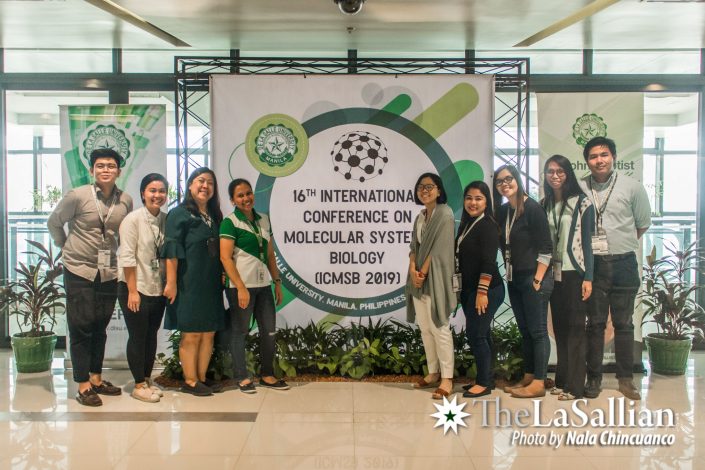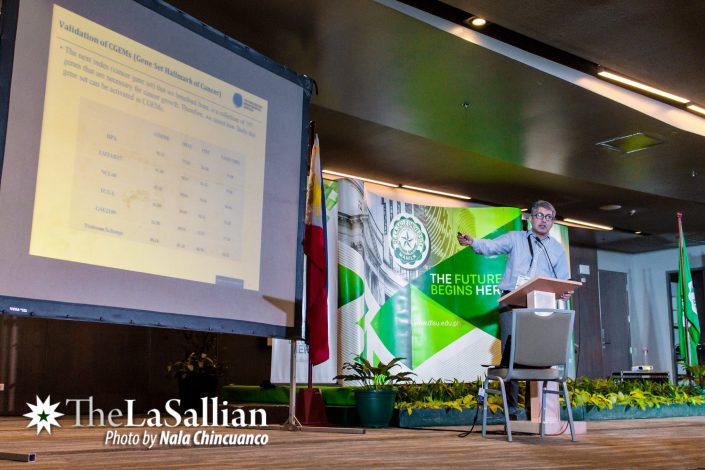The International Conference on Molecular Systems Biology (ICMSB) has continually contributed numerous groundbreaking research studies in the domains of Biochemical Systems Theory (BST) and Metabolic Control Theory (MCT)—two computational frameworks that are geared toward the analysis of biological systems, which span from cells to complex ecosystems.
On its 16th iteration, this year’s ICMSB—held last October 28 to 30 at The Verdure, fourth floor of the Henry Sy Sr. Hall—celebrated the 50th anniversary of Dr. Michael Savageau’s revolutionary research journal on BST. Chaired by Dr. Angelyn Lao, an Associate Professor from the Mathematics and Statistics Department of the University, this conference also marked the second time the biennial conference was held in the Philippines, with the first one held at the University of the Philippines Diliman in 2008.
Regarded as pioneers in the field of Systems Biology and the founders of the conference, Savageau and Dr. Eberhard Voit were joined by several scholars from around the globe during the recently concluded conference, which delved deeper into the integration of quantitative sciences with the life sciences in a series of talks and presentations.

From the pioneers
In simpler terms, BST refers to the mathematical modeling framework for simulating biochemical systems and the dynamic relationships among their components, mapping how a relative change in one quantity may result in a proportional relative change in the other. On the other hand, MCT is the method of mathematical modeling that analyzes a metabolic system’s sensitivity to disturbances in its environment or in its internal system. Both approaches are aimed at capturing how a living system in its entirety operates—a big picture perspective that welcomes complexity, as opposed to a reductive or zoomed-in method.
In an interview with The LaSallian, Savageau—who is also a Biomedical Engineering professor at the University of California, Davis—reveals he only became involved in the field during the later years of his undergraduate engineering degree. He narrates, “I was [utilizing] engineering training and thought process in [solving] problems of Biology. That sort of combination led me to my interest in BST.”
In his own words, he describes BST as an “intersection” of the fields of Biology and quantitative science. “Traditionally, Biology does not have a lot of Mathematics in it. With the Human Genome Project (HGP), it suddenly became clear that there’s so much data, [and] that biologists need Mathematics and computers to make sense of [these],” he remarks.
The HGP, which started in 1990 and ended in 2003, targeted to identify the sequence of the base pairs that make up the human deoxyribonucleic acid or DNA—that is, the arrangement of numerous adenine, guanine, cytosine, and thymine molecules comprising the entire set of genes of the human species. Although already finished, data from HGP’s follow-on projects continue to be analyzed by researchers worldwide.
For Voit, he discloses that he was always interested in both Biology and Mathematics, which eventually propelled him to become the University of Cologne’s first graduate of a double degree in the two said fields. “People said I was crazy. Now, we know Biology is too complicated that we need to use Mathematics,” he explains, echoing Savageau’s sentiments on there being “too much data that the human mind alone cannot comprehend.”
Discerning theories
Biology, along with most scientific disciplines, is no stranger to the ‘tsunami-esque’ technological tidal wave that has been taking the world by storm in recent years. The rapid emergence of technological innovations, particularly advancements in computational tools, has also manifested in the development of the life sciences.
This much was evident in the variety of talks conducted during the conference, showing how the models were widely applicable to many subject areas. Among the topics emphasized in the conference were modifications of an organism’s genetic composition, trade-offs in biological error correction, and cancer therapy.
In his keynote address, Savageau introduced a phenotype-centric method of biological modeling to describe the evolutionary stability of plants. Some physical traits or phenotypes aid an organism to thrive in a specific type of environment, such that the genes that produce those phenotypes flourish in the population. Changes in the environment usually bring about changes in these good traits. However, in an evolutionarily stable state, the prevailing genotypes are preferred over alternatives, and therefore remain unchanged, leading to robust species—or those that can tolerate genetic changes in response to environmental changes.
The traditional strategy for understanding the interplay between environment and species traits is simulation-centric: it uses trial and error in estimating the factors, also called parameters, that affect an organism’s genes and phenotypes. During validation, if the estimated parameter values do not match existing experimental data, the model has to be repeatedly refined. Meanwhile, the phenotype-centric model inverts the process, beginning with enumerating the phenotypes then determining which parameters must be manipulated in order to achieve a certain outcome.
On the second day of the conference, Voit presented a computational model that gauged interactions among neurotransmitters—the chemical messengers that send information from one neuron to the next throughout the body’s nervous system—and showed how imbalances in these chemicals affect different brain regions of patients with schizophrenia, a mental disorder that affects how a person thinks, feels, and behaves. Some symptoms include hallucinations, reduced expression of emotions, poor ability to understand and retain information, among others.
The simulation results demonstrated similarity to the available clinical data at the time. Voit also added that the model was able to display the effects of different medications on the patients’ neurotransmitter balance and working memory.
Afterward, Dr. Oleg Igoshin of Rice University presented a theoretical framework that probed the trade-offs between the speed and accuracy of two important biological processes: DNA replication and selection of tRNA or transfer ribonucleic acids. tRNAs are molecules that carry the amino acids used to form proteins during translation, the final step in the central dogma or the process of converting information from the DNA in genes to the protein end product.
Igoshin explained that when trade-offs do arise in cellular systems, speed tends to be prioritized over accuracy, as long as it is within the margin of error. This enables the biological system to enact proofreading or corrective mechanisms to minimize the possibility of mutations without slowing down the process.
Opening the conference’s third and final day, Dr. Kwang-Hyun Cho from Korea Advanced Institute of Science and Technology discussed how mathematical techniques could be employed for the analysis of cancer, proposing a methodology that aimed to address the erratic attributes exhibited by cancer cells upon exposure to medication.
Cho explained that the mutations in the genome that give rise to cancer tumors also affect the signaling networks that regulate cellular response and activities. Rather than relying on trial and error to determine the most appropriate treatments for patients, he suggested that mapping the dynamics of such cancer networks would aid in identifying where alterations in the genes have occurred—which could then become sites for therapeutic targets—as well as in predicting how the cells might respond to different treatments.
Lastly, Dr. Eduardo Mendoza, an Adjunct Professor from DLSU’s Mathematics and Statistics Department, presented the benefits of synthesizing two modeling approaches: BST and Chemical Reaction Network (CRN) Theory, a mathematical approach that studies the kinetics or rates at which chemical reactions proceed, alongside concepts of reactant concentrations and equilibria. Mendoza illustrated this connection through decompositions of CRNs, or breaking down the network into subnetworks with separate reaction elements, revealing components that could be applied to biological systems modeled using the BST approach.
Recollection
When ICMSB was first organized in 1989, it was then only attended by around 30 individuals; but over three decades, parallel to the advancements in Systems Biology itself, the conference has grown to become a global gathering, having been held in countries such as Portugal, Spain, Norway, Japan, China, and Germany. Despite touting the field to still be in its “infancy stage” relative to other long-established sciences, ICMSB co-founders Savageau and Voit are far from alone in their endeavors toward the development of both the conference and the discipline of BST.
“When we started, it was not a discipline [of its own]…Our tools were so primitive that we really couldn’t do all that much. Now, it has become very different,” Voit recalls the “tipping point” of the flourishing of BST. “It really changed within a few years—from not being recognized at all to [being] something that was desirable.”
Amid all these, the co-founder is hopeful that “this is just the beginning.” “It’s incredible that it grew and is still growing…I think it will develop much, much further in the next [few] years,” says Voit.
with reports from Jasper Buan


